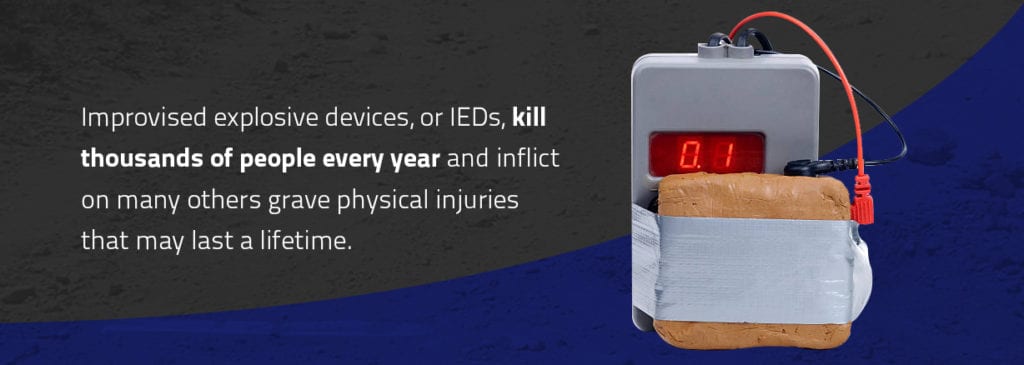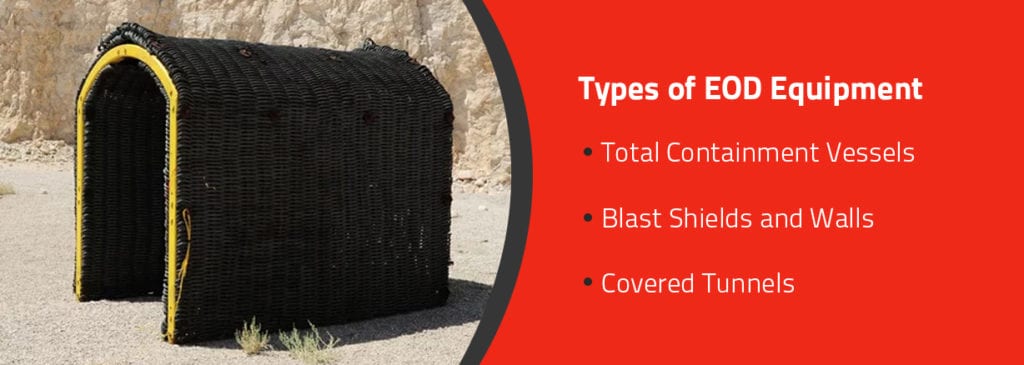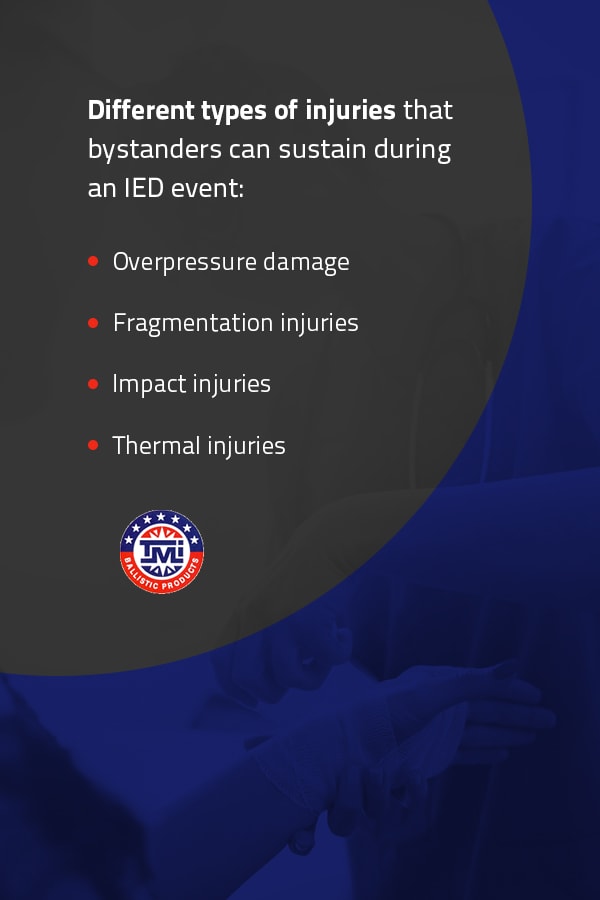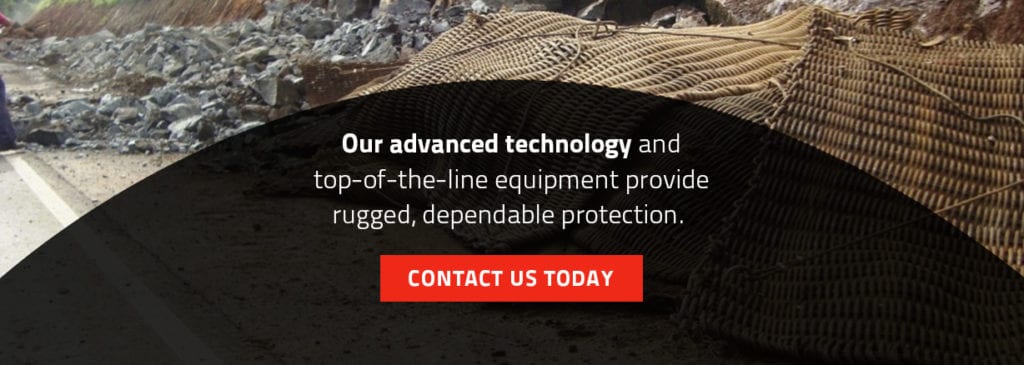
Imagine yourself as part of a tactical team. You have received a report of a bomb attached to the side of a building near a bustling intersection. Your team hurries to grab the necessary gear, give instructions to clear the area of civilians and race to the site.
In the old days, a specialist in bomb defusing might have worked on the device at the scene for several hair-raising hours, trying to defuse the bomb and neutralize its explosive power. Instead, your team pulls up with a trailer containing a state-of-the-art bomb containment vessel and a specialized robot. The robot uses its sophisticated clawlike appendage to pick up the bomb and carefully place it inside the bomb disposal container. From a safe distance, a bomb disposal technician locks the pressurized door.
Learn More About Blast Protection for EOD Teams
As the door clicks into place, the assembled squad personnel breathe a collective sigh of relief. You can now drive the bomb to a safe site for disassembly, knowing that if it detonates in transit, no one on your team or in the streets will become a casualty.
Is this scenario realistic? Increasingly, the answer is yes. And such equipment is becoming necessary to prevent debilitating injuries and save lives.
The Proliferation of Improvised Explosive Devices

Improvised explosive devices, or IEDs, kill thousands of people every year and inflict on many others grave physical injuries that may last a lifetime. Incidents involving IEDs have taken place in 66 countries and territories that span several continents. In eight of those countries, 1,000 or more civilians died from IED attacks.
Worldwide, an estimated 4,300 IED attacks have resulted in over 65,000 casualties in the past few years. Three-quarters of these casualties are civilians. Over the last decade, 367 of those civilians have been humanitarian aid workers. And 62% of IED attacks occur in dense, populated areas, leading to an ever-greater likelihood of civilian casualties.
IEDs are relatively cheap and easy to make. People can construct them from readily available materials, from household tools like pressure cookers and electronic wiring to mining explosives and even certain types of fertilizers. Instructions are readily accessible online or in flyers distributed among members of terrorist organizations. These IEDs are incredibly effective weapons for insurgent groups because they inflict destruction and casualties impersonally, without exposing members of the groups to retaliatory fire. Because of these factors, the incidence of IED attacks is not likely to decrease anytime soon.
And of course, not all bombs are IEDs. Devices from land mines to more sophisticated weaponry made of military-grade explosives all pose risks.
Bomb Disposal Containment Devices and EOD Equipment
EOD, or explosive ordnance disposal, is one of the highest of high-stakes jobs. Bomb-squad personnel put their lives in danger as they retrieve and defuse explosive devices. They also have the critical responsibility of keeping civilians and their teams safe from explosive detonations.
Specialized bomb disposal tools these professionals can trust to get the job done are crucial in these high-stakes environments. Quality equipment minimizes the danger to police and military personnel and ensures they can quickly contain and defuse a bomb. Safety and security are paramount, and it's vital to know how to use EOD equipment safely and effectively to avoid jeopardizing the team and putting civilian lives at risk.
Request a Quote for EOD Blast Containment Devices
Types of EOD Equipment

A few types of robust, reliable EOD equipment are currently available on the market.
1. Total Containment Vessels
One type of bomb disposal device is a total containment vessel or blast containment tank. These vessels neutralize explosive threats by allowing experts to detonate bombs safely in a tightly contained environment without injuring tactical teams or civilians. We will discuss total containment vessels in more detail below.
See Our Blast Containment Tank in Action
2. Blast Shields and Walls
Blast shields and walls also help protect against explosive device detonations. Unlike total containment vessels, they cannot surround an explosive device. However, they consist of high-quality patented steel wire rope, and they provide comprehensive protection against blast pressure and flying projectiles from a specific direction.
Blast shields and walls are entirely fireproof and can minimize blast pressure by 50 to 80%. They can withstand the force of a car bomb with over 280 pounds of TNT, and they also vent hazardous fumes safely. They are lightweight and easy to transport and install, and they can be linked together in a series of panels to provide complete barrier protection over a large wall or building.
Blast shields and walls are often used to protect industrial processing plants, research facilities, transit centers and other structures that attract an increased likelihood of explosions. They can protect buildings, quarantine high-risk facilities, mitigate the spread of explosion-caused fires and provide shielded areas where individuals can go through screening processes in potentially dangerous locations — airports or train stations, for example.
Blast shields and walls have a documented history of saving lives. In 2008, an explosion occurred at a chemical plant in West Virginia. Fortunately, the facility had installed blast walls around the high-risk area. During the accident, many small flying particles approached the speed of sound, and one large projectile hit a top speed of nearly 100 miles per hour. However, TM International, LLC's blast walls effectively contained the explosive debris in a small area and prevented casualties from the incident.
Learn More About Our Blast Shields & Walls
3. Covered Tunnels
Covered tunnels shield individuals, rather than protecting buildings and other large structures. Though in theory, it would be safer, it's not feasible to have individuals cram themselves into tiny bombproof chambers for protection as if they were magician's assistants preparing to disappear. So tunnels allow for a practical solution.
Covered bombproof tunnels often protect security checkpoints, border crossings, schools, stadiums and other high-traffic, high-risk areas. They provide more intimate and contained shielding than walls, while still permitting the flow of traffic.
Like other types of EOD equipment, covered tunnels consist of proprietary steel wire rope, which makes them both fireproof and shrapnel proof. They are lightweight and easy to transport and install. Their modular construction also makes it possible to connect multiple units to create a larger screening area without reducing the level of protection.
Learn More About Creating Blastproof Checkpoints
What Is a Total Containment Vessel?
A New York City bomb squad's commanding officer has described a total containment vessel as "an inside-out diving vessel." Whereas a diving vessel protects a diver by keeping the immense pressure of the ocean out, a total containment vessel keeps outsiders safe by keeping the enormous pressure of an exploding bomb safe within its chamber. The chamber contains tiny vents that allow air pressure to escape harmlessly, while containing the force of the bomb and all its shrapnel.
A total containment vessel typically consists of a core chamber, a frame and a control panel a bomb technician can use to operate the container from a safe distance. These vessels usually mount on trucks or tag-along trailers to facilitate transport away from high-traffic areas. When an explosive device is safely inside, the chamber will contain the blast pressure and flying debris of a detonation. Bomb teams can then drive the chamber and the device to specialized bomb disposal facilities.
Military EOD units and police bomb disposal units frequently buy total containment vessels — the NYPD has at least three, spread out across the five boroughs — but less militarized customers buy them as well. The campus police of the University of Georgia became the first campus law enforcement agency in the United States to own a total containment vessel with its purchase of one in 2009.
Some chambers are spherical and have round doors, similar to those found on commercial or household dryers, that can lock in place. They typically also have internal trays or baskets to house the explosive device and a yoke that opens and closes the access door. Locking this door contains the bomb safely.
Other bomb containment vessels are barrel-shaped containers. Like blast shields and walls, they consist of patented steel wire rope, capped at either end with heavy-duty blastproof metal. These total containment vessels are lightweight and extremely portable. They are also fireproof and powerful. They can contain 100% of the flying shrapnel generated with the detonation of an explosive device, even at extremely high velocities, and they can also contain 50 to 80% of the blast pressure generated by the force of the explosion. The minuscule spaces between the cables of wire rope allow fumes and pressure to vent safely without letting bomb fragments escape.
For these reasons, bomb disposal squads can allow explosive devices to detonate inside the tough containment vessels without worrying about property damage to the surrounding area or injuries or casualties among the civilian population. These total containment vessels are so durable that even after surviving one detonation, they typically remain unscathed. They are good as new and ready to perform at peak strength for the next device.
Using a Bomb Containment Vessel
A total containment vessel can completely contain the shrapnel and pressure of a bomb that explodes inside it. It is so strong that it can withstand the force of over 25 pounds of exploding TNT. Some total containment vessels can contain chemical and biological weapons, as well as explosive devices.
One other beauty of the bomb containment vessel is that bomb-disposal units do not have to evacuate neighborhoods or close down streets once they have an IED safely locked inside the chamber. If the bomb detonates inside the vessel, it will merely make a metallic clanging noise and a bright, flaming flash of light.
If the bomb remains stubbornly intact inside the containment vessel, the bomb disposal unit can safely transport the device to a specialized location. There, personnel can take apart, analyze and dispose of its components. They can also blow the bomb up safely in that controlled environment.
Bomb disposal units frequently use robots along with a bomb disposal containment device for added safety. A robot can retrieve the explosive device and place it inside the vessel. Robots' ability to perform these tasks means police officers and military personnel do not need to put their lives at unnecessary risk by handling a bomb.
Types of Explosive Device Damage Bomb Containment Vessels Prevent

The Department of Homeland Security breaks down the different types of injuries bystanders can sustain during an IED event.
- Overpressure damage: Blast pressure can damage a person's delicate organs, even if no flying shrapnel has penetrated them. Overpressure injuries can damage the ears, abdomen and lungs, in particular. A condition known as "blast lung injury," in which the extreme pressure from an explosion collapses the lungs, is one of the primary causes of injury and death from an explosive device.
- Fragmentation injuries: Flying shrapnel from the bomb and small, airborne pieces of debris cause fragmentation injuries. These shards penetrate the human body with stupendous force and can lead to severe injuries.
- Impact injuries: Impact injuries frequently lead to dismemberment, head trauma, lacerations, contusions and broken bones. These injuries typically occur when the force of the blast catapults a person through the air and the person slams into another object such as a building, wall or automobile.
- Thermal injuries: These occur when fire and smoke from the explosion burn the skin or damage the lungs and nasal passages.
- Miscellaneous injuries: Several other issues, such as crushing injuries and inhalation of toxic material, are possible in the immediate aftermath of a detonation. The explosion may also exacerbate existing ailments such as chronic heart or lung disease.
Delayed injuries may also present after a few days. Injuries to the eyes or abdominal organs, in particular, may not be noticeable immediately. They may cause symptoms or sudden fatalities up to several months after the explosion takes place. Additionally, the detonation of an IED may lead to secondary explosions if explosive material ignites nearby sources of natural gas or reserves of gasoline. Explosions can also lead to fires, ruptured water mains and gas lines, downed power lines and toxic smoke, which can also cause serious injuries and casualties.
Bomb containment vessels protect against every one of these types of injuries. If EOD squads can get the bomb into the total containment vessel before it explodes, the containment vessel will spare the mission team and civilian bystanders from these grave harms.
Contact TM International, LLC for Blast Containment Tanks
TM International, LLC knows EOD inside and out. We have over 100 years of experience in protecting against explosive devices, and we are ready to provide custom solutions and comprehensive protection to any level of military, law enforcement or private security bomb disposal squads. Our advanced technology and top-of-the-line equipment provide rugged, dependable protection. Reusable and reliable, our EOD devices and bomb disposal tools fit within a realistic budget while offering maximum security.
Military personnel and police bomb squads can rely on TM International, LLC for blast containment tanks to help neutralize the grave threat that comes along with disposing of explosive devices. Contact us today to get a personalized quote for all your equipment needs.

